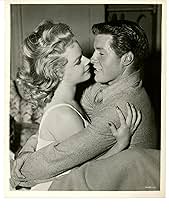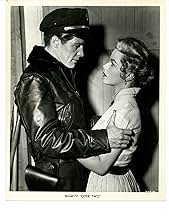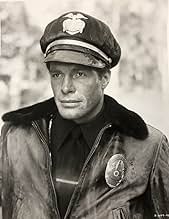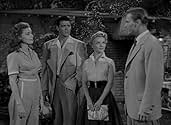Las aventuras de los policías en moto, desde sus días de academia hasta la persecución de camioneros corruptos.Las aventuras de los policías en moto, desde sus días de academia hasta la persecución de camioneros corruptos.Las aventuras de los policías en moto, desde sus días de academia hasta la persecución de camioneros corruptos.
- Dirección
- Guionistas
- Elenco
George Barrows
- Henchman with Rifle
- (sin créditos)
Margaret Bert
- Rural Driver's Wife
- (sin créditos)
Robert Carson
- Homicide Detective
- (sin créditos)
Phil Chambers
- Police First Sergeant
- (sin créditos)
John Close
- Police Lieutenant
- (sin créditos)
Chuck Connors
- Deputy Sheriff
- (sin créditos)
Fred Datig Jr.
- Police Candidate
- (sin créditos)
- Dirección
- Guionistas
- Todo el elenco y el equipo
- Producción, taquilla y más en IMDbPro
Opiniones destacadas
Solid little programmer from MGM's B period. The documentary influence of TV's Dragnet (1951-1959) is apparent in the early police training segment that looks like it was done at the actual Academy. Three trainees buddy-up there, but later switch to the better-paying motorcycle division. There they get involved with black market beef haulers and excitement ensues. Director Wilcox keeps things moving smoothly, while the filming in and around LA lends a realistic feel. Then too, Wynn gets to practice his tart brand of sarcasm as a tough but fair training officer, lending helpful color. As could be expected, the girls (Forrest and Stewart) are strictly secondary, as wife and girlfriend, respectively.
Meeker gets to play a cocky trainee in what could have been a warm-up for his classic Mike Hammer in Kiss Me Deadly (1955). I hope they paid him double for all his stunt work at the end. He earns it. For fans of two-wheelers, there's a lot of motorcycle cross-country action that shows off their rugged versatility. And what a coincidence, as another reviewer points out, that so many of the male cast went on to cowboy starring roles on TV—look for Chuck Connors as a deputy sheriff in an office scene about 2/3 of the way through. All in all, it's a solid programmer of the sort soon to migrate to TV, but holds interest, nevertheless.
Meeker gets to play a cocky trainee in what could have been a warm-up for his classic Mike Hammer in Kiss Me Deadly (1955). I hope they paid him double for all his stunt work at the end. He earns it. For fans of two-wheelers, there's a lot of motorcycle cross-country action that shows off their rugged versatility. And what a coincidence, as another reviewer points out, that so many of the male cast went on to cowboy starring roles on TV—look for Chuck Connors as a deputy sheriff in an office scene about 2/3 of the way through. All in all, it's a solid programmer of the sort soon to migrate to TV, but holds interest, nevertheless.
The first half of this modest 69-minute movie tells, in semi-documentary fashion, of the training of rookie cops in early 1950s Los Angeles. Needless to say, all these rookies are white males but it's the "dated" quality of the movie which lends it a curiosity value as an artifact of its time. Police buffs should enjoy looking over the equipment, the uniforms, the training techniques, the investigation methods, etc.
A let's-catch-the-cop-killers plot takes over in the second half. It's minor stuff but affords an opportunity to look over a cast soon to find greater success in TV westerns. There's Robert ("Wagon Train") Horton and Jeff ("Jefferson Drum") Richards and -- in a small part -- Chuck ("The Rifleman") Connors. Rounding out the cast of cops are Ralph Meeker and Keenan Wynn. There's a certain "fetish" appeal in seeing these men in boots and leather jackets and motorcycle pants, and Meeker, Horton, and Richards also do a "beefcake" scene by a lake where they appear in swimsuits. (Richards must have tipped the wardrobe department to give him the snuggest-fitting suit.)
A few scenes appear to be shot on actual L.A. streets but much of it is recognizable as the MGM back-lot. Somewhere, on one of those hills, Robert Horton would soon be stripped to his shorts and tortured by North Korean guards in "Prisoner of War."
Director Fred Wilcox later helmed the classic "Forbidden Planet."
A let's-catch-the-cop-killers plot takes over in the second half. It's minor stuff but affords an opportunity to look over a cast soon to find greater success in TV westerns. There's Robert ("Wagon Train") Horton and Jeff ("Jefferson Drum") Richards and -- in a small part -- Chuck ("The Rifleman") Connors. Rounding out the cast of cops are Ralph Meeker and Keenan Wynn. There's a certain "fetish" appeal in seeing these men in boots and leather jackets and motorcycle pants, and Meeker, Horton, and Richards also do a "beefcake" scene by a lake where they appear in swimsuits. (Richards must have tipped the wardrobe department to give him the snuggest-fitting suit.)
A few scenes appear to be shot on actual L.A. streets but much of it is recognizable as the MGM back-lot. Somewhere, on one of those hills, Robert Horton would soon be stripped to his shorts and tortured by North Korean guards in "Prisoner of War."
Director Fred Wilcox later helmed the classic "Forbidden Planet."
I saw this movie as a kid when i was about 13 or so. I remeber this as one of the coolest movies I have ever seen. I am sure, now it would seem a little less dramatic, but it has stayed with me all these years. There is one scene where the truck hijackers are stopped by a cycle cop and when they get the chance to knock him out they do. They then take him and put him under the tires of the big rig and {pretty violent for back then} back up over him. A young chuck Conners, Ralph Meeker and Keenan Wynn make this a must see for biker, crime and film noir fans. I believe Ted Turner owns this movie and I wish he would release it on video. Enjoy the film if you can ever see it.
I was an LAPD Explorer in the late 1960"s and had shot on the Academy pistol range. The movie showed the Los Angeles Police Department Headquarters (outside) before Parker Center was built. It also showed the real Academy with the pool, parade ground, a fenced area, indoor training area, dispatch, and pistol range. The part that was not real was the dining room. The dining room looked like a movie set. Some of the the motorcycle training looked real too like laying down the bike and driving through the cones. Like I learned during my motorcycle training course (civilian), it does not take much of a rider to go fast. The trick is how slow can you go!. It was also interesting how the movie gave a plug for the Los Angeles County Sheriff's Department. The movie had everything I like bikes, guns, and cops. What else is there.
Have for a while been on a roll tracking down and watching not so well known (near-obscure in some cases) films from filmographies of actors/actresses that varied from very famous to practically forgotten today. In 'Code Two's' case Ralph Meeker and Keenan Wynn were the best-known of the cast. Also have always really liked the genre and liked the concept, so they were further reasons for wanting to see 'Code Two'. If it weren't for me seeing a few of Meeker's films recently, this film's existence would still be unknown to me.
On the whole, 'Code Two' is worth tracking down, even non-motorcycling fans should find some worth (speaking as one but appreciate them), and that it is near-forgotten today is not that deserved. It is not a great film, or an essential, and is a film of two halves in my view, one a good deal stronger than the other. There are though a lot of strong things about it and anybody that loves the genre should see it for at least completest sake.
'Code Two' isn't perfect. Some of the first half is nostalgic and amusing and the atmosphere of the academy is done accurately, but it is also rather exposition-heavy, thin on plot and takes too long to set up. The second half is certainly much better, but it did mean that it was like seeing two films in one and of two different tones, one more nostalgic and light-hearted and the other grittier and more tough.
Meeker does give a confident performance in the lead and it is the sort of role that suits him well, sadly though Chuck is agreed quite obnoxious and not easy to get behind. The very end felt on the cheesy side and jarred by the quite suspenseful build up.
However, 'Code Two' has a very effectively noir-ish look in especially the second half. The semi-docmentary look of the truly startling and quite brutal opening is also incredibly effective and hits hard. The music serves its purpose well and fits at least, not over-emphasising the mood. The direction is assured and a good mix of affectionate and unyielding on the most part, apart from some lapses in momentum in more expositionary moments. The motorcycles are very cool and will be a treat for anybody that has an interest in them.
The script has entertainment value and tautness and while the first half was for me flawed the film did start off brilliantly with an opening that as said hits hard. The second half, also as already said, is the stronger and much more consistent half. It isn't earth shattering originality wise, but more than makes up for it with its tight pace, its grim tension and its non-holding back atmosphere. Meeker, despite his character, carries the film well and is very well supported by Wynn (as a contender for the most interesting character), sympathetic Elaine Stewart and Robert Horton.
All in all, uneven but above average curiosity. 6/10
On the whole, 'Code Two' is worth tracking down, even non-motorcycling fans should find some worth (speaking as one but appreciate them), and that it is near-forgotten today is not that deserved. It is not a great film, or an essential, and is a film of two halves in my view, one a good deal stronger than the other. There are though a lot of strong things about it and anybody that loves the genre should see it for at least completest sake.
'Code Two' isn't perfect. Some of the first half is nostalgic and amusing and the atmosphere of the academy is done accurately, but it is also rather exposition-heavy, thin on plot and takes too long to set up. The second half is certainly much better, but it did mean that it was like seeing two films in one and of two different tones, one more nostalgic and light-hearted and the other grittier and more tough.
Meeker does give a confident performance in the lead and it is the sort of role that suits him well, sadly though Chuck is agreed quite obnoxious and not easy to get behind. The very end felt on the cheesy side and jarred by the quite suspenseful build up.
However, 'Code Two' has a very effectively noir-ish look in especially the second half. The semi-docmentary look of the truly startling and quite brutal opening is also incredibly effective and hits hard. The music serves its purpose well and fits at least, not over-emphasising the mood. The direction is assured and a good mix of affectionate and unyielding on the most part, apart from some lapses in momentum in more expositionary moments. The motorcycles are very cool and will be a treat for anybody that has an interest in them.
The script has entertainment value and tautness and while the first half was for me flawed the film did start off brilliantly with an opening that as said hits hard. The second half, also as already said, is the stronger and much more consistent half. It isn't earth shattering originality wise, but more than makes up for it with its tight pace, its grim tension and its non-holding back atmosphere. Meeker, despite his character, carries the film well and is very well supported by Wynn (as a contender for the most interesting character), sympathetic Elaine Stewart and Robert Horton.
All in all, uneven but above average curiosity. 6/10
¿Sabías que…?
- TriviaThe art on the cover of the Warner Brothers Archive Collection DVD shows Ralph Meeker laying next to Elaine Stewart in a bathing suit. In the movie, it is Jeff Richards who is next to Stewart in this scene, whereas Meeker is in a canoe with his girlfriend. This art may be from an original lobby card for this movie or maybe was created specifically for the DVD box art.
- ErroresWhen O'Flair is fighting the bad guy with a meat cleaver, the bad guy takes a couple of swings at O'Flair and misses, hitting the wall instead. Before that, you can see about a dozen marks in the wall from previous takes.
Selecciones populares
Inicia sesión para calificar y agrega a la lista de videos para obtener recomendaciones personalizadas
Detalles
Taquilla
- Presupuesto
- USD 472,000 (estimado)
- Tiempo de ejecución1 hora 9 minutos
- Color
- Relación de aspecto
- 1.37 : 1
Contribuir a esta página
Sugiere una edición o agrega el contenido que falta

Principales brechas de datos
By what name was Code Two (1953) officially released in India in English?
Responda























